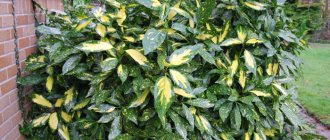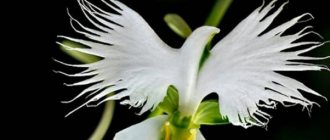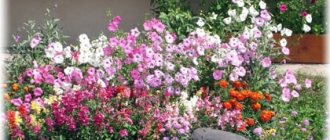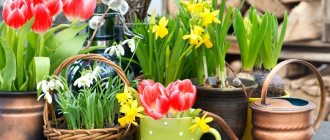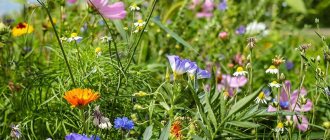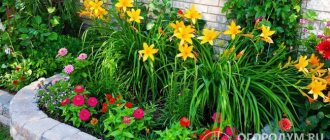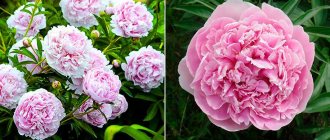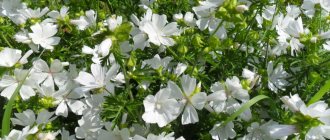Ornamental plants translated from Latin decoro (I decorate) are a group of wild and cultivated plants of different families. Ornamental plants include indoor and garden plants, which can be annual or perennial.
The main function of this group is landscaping and decoration of houses, gardens, settlements, alleys in cities and parks, decoration of buildings and private houses.
Now more and more gardeners have begun to grow ornamental plants in addition to fruit plants. Properly selected varieties and their combination will perfectly decorate your garden. With the help of decorative bushes and flowers, unique landscape designs are created. They differ in their shape, flowering, decorative fruits, leaves and color.
There are a large number of types adapted specifically for your climate zone with the desired temperature regime.
Decorative low-growing trees and shrubs are used as compositions. They, in turn, are divided into decorative deciduous, flowering and evergreen, cereals, and bulbous.
Flowering ornamental varieties attract with their unique, but, unfortunately, very short flowering, so when creating landscape design they use coniferous evergreen ornamental bushes and trees that remain green throughout the year.
Spreading species (oak, ash) and umbrella-shaped species (silky acacia) are used in plantings.
Weeping species will perfectly decorate reservoirs and decorative ponds (weeping birch, willow).
Creeping species are used in rock gardens and rocky hills (horizontal cotoneaster, juniper, mountain pine).
Deciduous plants change their color from spring to autumn with a dormant period (wintering).
Streets and parks are decorated with pyramidal and spherical trees (poplar, cypress, privet, laurel, thuja, boxwood, hawthorn).
For landscaping private houses and fences, climbing forms (ivy, ampelopsis, grapes, etc.) are used.
Decorative garden plants
Planting ornamental shrubs can transform a former construction site or wasteland into a luxurious oasis in a few hours, if they were purchased in pots already grown. After purchase, they are replanted with a lump of earth.
In this case, all conditions regarding the characteristics of the soil and the degree of frost resistance should be taken into account. In view of this, you should choose those plants that will feel most comfortable on your site.
All trees and shrubs are divided into three types: beautifully flowering, evergreen and decorative deciduous garden plants.
Almost every person is familiar with such flowering ornamental shrubs as white acacia, perennial rose hips, and medicinal fragrant lilacs. Let's talk about other garden plants that have a more exotic appearance.
Highlander tent
Highlander is ideal for decorating a garden recreation area: several frame posts and a mesh between them are installed above the selected area.
The vines of the mountaineer shoot along the support pillars, which will very quickly weave the entire space and cover the recreation area with a natural tent.
Rhododendron
These shrubs and trees are divided into deciduous, semi-deciduous and evergreen. According to various sources, this genus has more than a thousand species, including azaleas, popular among gardeners.
Literally, “rhododendron” is translated as “tree with roses” or “rose tree.” The reason for this name lies in the fact that azalea flowers look very much like roses.
This plant loves the climate of the coastal sea or river zone, therefore in the wild Rhododendron is most common in the south of China, the Himalayas, Japan and North America.
Some species can reach a height of more than three hundred centimeters, and the flowers vary in shape, size and color.
It blooms in large clusters of flowers that have an incredibly beautiful pink or purple hue.
- Evergreens - a complete list with descriptions and recommendations from a gardener
Vertical gardening - from idea to implementation, choosing options according to budget and attractiveness (photo + video)
- Vertical flower beds - basic principles and rules for choosing plants and arranging a suburban area with your own hands
It requires warm temperatures and therefore can freeze in winter. And only a few varieties are adapted to the climatic conditions of the middle zone.
Herbs and perennial flowers
It is profitable to plant perennial herbs and flowers for the garden - with the right choice of material and location, outdoor ornamental plants will delight the eye with a variety of colors and shapes for many years. Every year you can change the palette of colors - plant annual flowers between perennials.
Useful information: Growing daffodils
Arabis or rezuha (Arabis)
Arabis are early-blooming honey-bearing groundcovers, the height of which, together with the peduncle, does not exceed 30 cm. The stem is climbing, rooting. The entire pubescent leaf is silvery-white in color and has denticles along the edge. Sometimes the basal leaves form a beautiful rosette. A dense umbrella-shaped inflorescence is formed from small pink, white, and purple flowers. Flowering is early (April) and long lasting – about two months.
Related article:
What is the name of a shrub with pink flowers?
Common garden varieties:
- Flore Pleno – height 30-35 cm, large, double, pink flower;
- Pink Frost – petals of delicate shades of pink;
- Rote Sensation – elongated leaf, pink petals:
- Shneehaube – double flower, white.
Astilbe
Representatives of the genus are rhizomatous herbaceous perennials, the above-ground part of which dies in the fall. The stems vary in height - 10-200 cm. The leaves of most species are beautifully dissected, with a finely toothed edge, the color is dark shades of green or reddish-green. The apical lush rhombic or pyramidal inflorescence consists of small flowers of various colors. If you select varieties with different flowering periods, then astilbe will decorate the area all summer.
Interesting varieties:
- A. Chinese (A. chinensis) - unpretentious, grows quickly, stems up to 1 m in height, glossy leaves, covered with red hairs along the edges, a beautiful dense inflorescence formed by lilac, white, pink flowers;
- Thunberg (A. thunbergii) - a dense, medium-high bush (up to 80 cm), the surface of the dark green carved leaf is covered with brownish hairs, the wide pyramidal large inflorescence consists of bright white small flowers, goes well with deciduous crops and ornamental grasses;
- Amethyst, Erica, Rubin, Serenade are beautiful varieties of Arends astilbe.
Periwinkle (Vinca)
A herbaceous creeping perennial will help out if there are shady areas where other crops do not grow well. It grows well both in wet lands and in those that quickly lose moisture. The stems are covered with small shiny leaves of dark shades of green, they grow quickly, occupying the provided area. The flowers are single, small, lilac, purple, blue, light blue, and pink. Blooms from spring until frost.
Related article:
Fragrant herbs in the garden
Types of periwinkle: large, small, pubescent, pink, herbaceous.
Spreading boron (Milium effusum)
A spectacular, beautiful herbaceous plant that will enliven and decorate a shady flower garden or a damp area of the garden. In mid-latitudes it winters without problems. Most decorative in spring and the first month of summer. A bunch of smooth flat yellow leaves against the background of familiar greenery looks like a lace pattern.
On a tall (40-50 cm) stem, peduncles form, drooping under the weight of yellowish-green flowers that look like millet seeds. Suspends development in extreme heat. Creates a contrast with blue hostas, brightly flowering annuals.
Dicentra magnificent (Lamprocapnos spectabilis)
In common people the flower is called “broken heart”. It blooms profusely and for a long time in partial shade, fades in the sun and quickly fades. The perennial is beautiful not only during flowering - the petioled leaves divided into lobes look original against the background of crops with a different shade of green.
Flowers with pink or white outer petals and reddish, white inner petals look like dangling hearts. The racemose inflorescence bends in the shape of an arc under their weight, which gives the bush a delicate outline.
Original varieties:
- Alba and Snowdrift - snowy white petals;
- Gold Heart - golden yellow leaf.
Italian bristlecone or mogar (Setaria italica)
Drought-resistant herbaceous annual that prefers bright sunny areas. The height varies - from 10 to 100 cm. Nowadays it is popular as an original ornamental plant, diluting the elegant beauty of garden crops with its simplicity.
Growing in the form of dense bunches (height from 50 to 150 cm), it forms a closed herbage. The leaf is long, rough, the inflorescence looks like a spike-shaped shaggy panicle. The flowering period lasts from July to August. Planted as a tapeworm, as a hedge, for cutting, for winter bouquets, for decorating paths, lawns, and diluting flower beds with greenery.
Camellia
This evergreen garden plant belongs to the tea family, which includes more than eighty species of different plants. They were named in honor of the priest and naturalist G.K. Camelius, who first brought these plants from the Philippines to Europe.
This genus consists of compact evergreen shrubs and trees with simple glossy leaves that are ovate in shape.
The leaves come with pointed and blunt ends; they grow separately from each other in two or three pieces. Numerous stamens are pink, red or white
The plant needs careful care, and lack of light, high temperature, lack of humidity or an unsuitable soil mixture can cause the death of the flower.
- Decorative grass - 140 photos of original design. Review of the best varieties of grass for the garden, instructions, reviews, videos + gardener recommendations
Watering the site - types and types of systems, main differences and features, rules for selection and installation, as well as recommendations for operation
Boxwood: planting, care, growing in open ground, propagation. Full description of the plant from A to Z. More than 100 photos of evergreen shrubs
Beneficial properties of house plants
Certain types of flowers purify the air from toxic substances released by furniture and finishing materials, detergents and cleaning products. Many plants absorb cigarette smoke, which is difficult to remove from the apartment.
Dracaena will cope with benzene and cleanse the air of exhaust gases that enter the room from the street. With the help of foliage, asparagus will help get rid of heavy metals. Cacti successfully neutralize radiation from televisions, computers and other household appliances. In addition to purification from gases and vapors, Chlorophytum is capable of destroying harmful microorganisms.
Tamarisk
Another lovely ornamental plant, shown in the photo, is beautifully called Beadweed or God's tree. Tamarisk took its scientific name from the Tama Riz River, which flows in the Pyrenees Mountains.
Bisernik mainly grows in deserts and sand dunes. It can be found in Africa, Asia and southern Europe.
This tree has more than fifteen species, and in the Caucasus it rises to a height of over six hundred meters. Deciduous or evergreen shrubs grow in a bush-like manner, reaching a height of one and a half to twelve meters. Their trunk, as a rule, is no thicker than half a meter.
Its crown has many twig-like stems, on which small leaf blades that look like scales are alternately located. Their color can be light or dark green, as well as emerald blue.
Yew
This evergreen coniferous plant is great for the garden because it provides year-round greenery on the site. About eight species of trees and shrubs belonging to the Yew family are characterized by rather slow growth.
This crop is in particular demand among gardeners who use coniferous plants in landscape design.
- Living fence - the best ideas on what to make a hedge from at your summer cottage. Many photos of ready-made options with exclusive designs + instructions
- Trimming bushes - the basics of choosing the right plants and forming the right shapes, selecting tools (photo + video)
Landscaping a site - basic principles and rules for creating a beautiful site with your own hands
Despite the fact that yew is an unpretentious and highly ornamental plant, year after year it becomes less and less in natural conditions.
Yew has a red-brown scaly bark, a multi-vertex cylindrical crown, and dark green soft needles. Thanks to its valuable wood with antibacterial properties, the plant is listed in the Red Book.
Scheme of planting flowers in a flower bed
A flower garden that is not thought out and planned in advance rarely looks beautiful. It is necessary to follow a certain planting scheme, taking into account the characteristics of each type of plant. You need to take care of this in the winter so that you can purchase seeds and plant them for seedlings in early spring.
Before buying seeds, you should think about how you can plant flowers beautifully, what flower beds you plan to create - they come in several types.
The basis of the flower bed consists of large flowers with tall stems. They are placed in the center. Background flowers are lower than the central ones, their inflorescences are usually not so bright and large, but they play an important role in building the composition: they are used to create a beautiful frame for the central part of the flower garden.
In general, plant height plays an important role. All flowers are divided into several main groups:
- Ground cover: purslane, saxifrage, pansy, periwinkle, muscari, primrose, Turkish carnation, blue forget-me-not, phlox. They look organically as borders and ridges; they are used to sow the free spaces of flower beds.
- Low-growing, not exceeding 30 centimeters: nasturtium, petunia, marigolds, lobelia, calceolaria, iberis, Chinese carnation, alpine asters.
- Medium-sized: geranium, chamomile, cosmos, zinnia, eschscholzia, delphinium, gladioli, astilbe, peonies.
- Tall: ferns, ornamental shrubs, trees. The most beautiful and popular are hydrangea, rhododendron, jasmine, tree peony, conifers, for example, yew, thuja, juniper.
In order for the flower garden to maintain its beauty at any time of the year, it is advisable to choose flowers taking into account their flowering periods. In early spring, daffodils, forget-me-nots, primroses, violets, scillas and snowdrops bloom.
Regular flower beds
They are distinguished by straight lines, geometric shapes, and complex patterns. Various types of classic flower beds, borders, and modular flower beds are considered regular.
Irregular flower beds
They consist of several groups of plants with different flowering cycles. They bloom in turn, due to which the flowerbed is filled with flowering plants all season.
Discounts
These are ordinary elongated, rectangular beds that consist of several rows of plants. This makes it possible to create picturesque stripes like carpet paths.
Multi-level or mixborders
Plants are planted in tiers, which allows you to focus on the beauty of each type of flower.
After choosing the shape of the flower bed, you should consider its color design. Designers distinguish three basic types of flower beds.
Monochrome flower garden. Plants of the same color or the same color scheme are planted. This solution is especially natural for a small flower garden. 2-4 varieties of flowers are enough, the tallest ones are placed in the middle, and the lowest ones are placed at its edges.
Contrasting flower beds. You should choose combinations that are opposite in location in the color spectrum. For example, yellow with blue, green with red, pink with blue, orange with blue. For special effect, you need to choose flowers in bright, saturated colors, although muted colors make the flower bed elegant and sophisticated.
Adjacent colors. They are selected in such a way as to ensure a smooth transition of shades. It is important to choose 2-3 colors adjacent to the color palette. For example, blue with blue, pink with lilac, red with purple.
Now you can draw up a diagram of the flower garden. According to tradition, the tallest flowers are planted in the center, then their height gradually decreases towards the edge of the flowerbed.
If the flower beds are located along walls or fences, the background is planted with the tallest plants, the shortest ones are placed in front. Several medium-height perennials are planted next to tall perennials.
It is advisable to sow all the free space of the flowerbed with low-growing ground cover plants or lawn grass, which form a kind of carpet.
You can choose one type of color or several, the main condition is that they match in tone and size.
Multi-tiered flower beds are good for limited area. For example, they build vertical wooden shelving, with which you can hide an unsightly place, decorate a fence, or zone an area.
Vertical flower beds can be in the form of flower pots fixed on special frames or rods. As the flowers grow, they usually cover the entire wall with a continuous carpet, especially if some climbing plant is planted here.
You can use old car tires of different diameters and stack them on top of each other. It is allowed to build a stepped structure from boards.
Decorative indoor plants
Growing beautifully flowering plants in pots began to be practiced back in the era of the Great Geographical Discoveries. Today, caring for indoor plants is a passion for millions of people around the world.
Flowers vary in shape, color and foliage characteristics and may be of local or distant origin. In any case, in the bustle of the city, they remind you of the enchanting delights of nature.
Plants in design
Decorative floriculture and landscape design are fairly well-known concepts for most flora lovers. However, novice gardeners or simply lovers of indoor plants quite often do not understand the intricacies of choosing and growing flowers, herbs, shrubs and trees designed to decorate their garden plot or apartment.
That is why it is so important to know what types of ornamental plants there are and how to choose the right type so that it not only performs its main functions well, but also brings a minimum of trouble to the owner.
Ornamental plants are divided into three main groups:
- for garden cultivation (used for landscaping and beautifying parks, squares, summer cottages and other outdoor areas);
- indoor (intended for growing in public and residential premises);
- aquarium group (aquatic vegetation bred in freshwater aquariums).
Balsam
This decorative flower is incredibly popular due to its unpretentiousness, almost constant flowering and easy propagation.
People call it affectionately the sparkle, impatiens or evergreen. Having appeared in Europe at the beginning of the 16th century, it was subsequently quite quickly spread throughout the world.
Its branched, succulent stems, depending on the variety, reach a height of fifteen to fifty centimeters. And the fleshy leaves with wavy edges are green-red, green or bronze in color.
Begonia
The name of this floral and ornamental plant dates back to the 17th century thanks to the monk Charles Plumier. While collecting plants in the Antilles, he discovered six species of flower of incredible beauty with decorative leaves and flowers.
The monk named his discovery in honor of his best friend, the governor of the island of Haiti, M. Begon. At the moment, there are about a thousand species of this plant and more than two thousand hybrids in nature.
Begonia is light-loving, but it should not be exposed to direct sunlight. Due to the fact that the plant is tropical, it requires high air humidity.
Caring for a flowerbed of continuous flowering
In such a flower bed there are constant changes all year round, and they require maintaining order:
- Remove faded flowers in a timely manner; they spoil the appearance and, as already mentioned, can lead to unwanted self-seeding. Withered leaves and overgrown branches also need to be cut off. Don’t try to keep up with all the flowers; after flowering, many of them will quickly disappear behind their grown-up neighbors; they simply won’t be visible. In this case, you should not go deep into the flower garden with scissors; withered plants will give up valuable nutrients to the earth.
- The desired procedure for a flower garden is fertilizing. There are many plants in such a flower bed, they all need food, so apply universal fertilizer in small quantities several times in spring and summer.
- A separate type of care is working with bulbous flowers. Most of them do not require digging in the fall, but there are exceptions: modern sensitive tulip hybrids may not tolerate frost. Choose for yourself; unusual beauties come with additional autumn-spring work. It makes sense to dig up other bulbous plants only if they have grown too much. In this case, wait until flowering ends and the stem dries. Then carefully, without damaging the neighbors, dig up the bulbs, separate them, dry them and store them until autumn.
A flowerbed of continuous flowering is a gardener’s masterpiece, but anyone can do it. If you are a beginner, start by researching and selecting annuals or a mono-bed of asters. After 3-4 years you will be able to create more complex compositions. If you are a professional, create different flower beds, including varieties that you have not yet discovered - this way you will please yourself and endlessly surprise your loved ones.
Pentas
This ornamental houseplant is also called Egyptian Star. It blooms at a time when there is practically no greenery outside the window, there is a lack of sunlight and one feels the imminent approach of winter.
The bright flowering cap of Pentas pleases the eye and lifts the mood from October to February, when it is cold and windy outside.
The flower can have different colors, it is not afraid of drafts, but after a long winter you should not expose it immediately to direct sunlight in order to avoid burning the leaves.
The flower should be accustomed to light gradually. It is worth considering that the most suitable place for it is the south window in the house.
